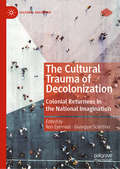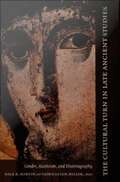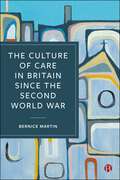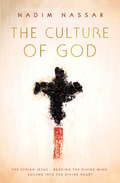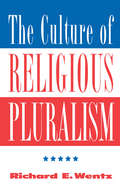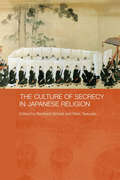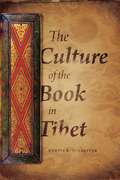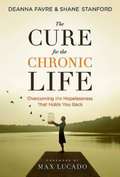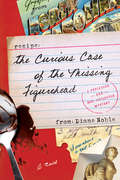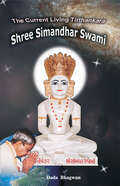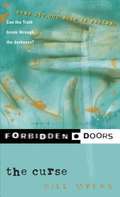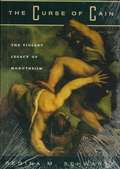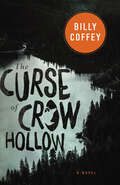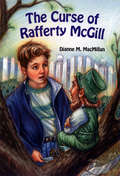- Table View
- List View
The Cultural Trauma of Decolonization: Colonial Returnees in the National Imagination (Cultural Sociology)
by Ron Eyerman Giuseppe SciortinoThis volume is first consistent effort to systematically analyze the features and consequences of colonial repatriation in comparative terms, examining the trajectories of returnees in six former colonial countries (Belgium, France, Italy, Japan, the Netherlands, and Portugal). Each contributor examines these cases through a shared cultural sociology frame, unifying the historical and sociological analyses carried out in the collection. More particularly, the book strengthens and improves one of the most important and popular current streams of cultural sociology, that of collective trauma. Using a comparative perspective to study the trajectories of similarly traumatized groups in different countries allows for not only a thick description of the return processes, but also a thick explanation of the mechanisms and factors shaping them. Learning from these various cases of colonial returnees, the authors have been able to develop a new theoretical framework that may help cultural sociologists to explain why seemingly similar claims of collective trauma and victimhood garner respect and recognition in certain contexts, but fail in others.
The Cultural Turn in Late Ancient Studies: Gender, Asceticism, and Historiography
by Dale B. Martin Patricia Cox MillerThe essays in this provocative collection exemplify the innovations that have characterized the relatively new field of late ancient studies. Focused on civilizations clustered mainly around the Mediterranean and covering the period between roughly 100 and 700 CE, scholars in this field have brought history and cultural studies to bear on theology and religious studies. They have adopted the methods of the social sciences and humanities--particularly those of sociology, cultural anthropology, and literary criticism. By emphasizing cultural and social history and considerations of gender and sexuality, scholars of late antiquity have revealed the late ancient world as far more varied than had previously been imagined. The contributors investigate three key concerns of late ancient studies: gender, asceticism, and historiography. They consider Macrina's scar, Mary's voice, and the harlot's body as well as Augustine, Jovinian, Gregory of Nazianzus, Julian, and Ephrem the Syrian. Whether examining how animal bodies figured as a means for understanding human passion and sexuality in the monastic communities of Egypt and Palestine or meditating on the almost modern epistemological crisis faced by Theodoret in attempting to overcome the barriers between the self and the wider world, these essays highlight emerging theoretical and critical developments in the field. Contributors. Daniel Boyarin, David Brakke, Virginia Burrus, Averil Cameron, Susanna Elm, James E. Goehring, Susan Ashbrook Harvey, David G. Hunter, Blake Leyerle, Dale B. Martin, Patricia Cox Miller, Philip Rousseau, Teresa M. Shaw, Maureen A. Tilley, Dennis E. Trout, Mark Vessey
The Cultural World of the Bible: An Illustrated Guide to Manners and Customs
by Victor H. MatthewsA leading expert on the social world of the Bible offers students a reliable guide to the manners and customs of the ancient world.
The Culture of Care in Britain since the Second World War
by Bernice MartinThis book examines the evolving value of caregiving in Britain, from the welfare state's inception to the present day. It explores the shifts in discourse surrounding care, charting key social, demographic, economic, political and cultural changes which have led to the current 'care crisis'. The author examines five key themes: the tension within institutional Christianity between caring for the marginalized versus maintaining 'respectability'; the secularization of the value of care and its interaction with emerging social divisions; the persistent expectation that women bear the caregiving burden; the economic and social undervaluation of emotional and practical care work; and the challenges facing the care and health sectors. The author suggests that recalibrating the tax system to shift the burden from incomes to profits may be necessary for the survival of welfare systems under these new conditions.
The Culture of Disbelief: How American Law and Politics Trivialize Religious Devotion
by Stephen L. CarterAmerican politics faces few greater dilemmas than deciding how to deal with the resurgence of religious belief.
The Culture of God: The Syrian Jesus - reading the divine mind, sailing into the divine heart
by Nadim Nassar'So much of the reporting of the Middle East at the moment reflects war and human misery; it's inspiring to find, in this thoughtful and engaging book, a message of hope from what Fr Nadim calls "that region of the world that God chose to live in when he took human form"' Edward Stourton'The ultimate question of this book is, why does it matter to me, a human being, to know the culture of God, and what impact should that have on my own life and existence? The culture of God is the antithesis of the culture of the Pharisees - yet again and again we fall into the trap of condemning or excluding others. Understanding the culture of God helps us to uncover God's image within us, a shining jewel buried deep under the dirt of our selfishness and greed, and helps us to shine as God intends us to, re-forming our relationships with God and with each other in our amazingly diverse world.'It is as we read the Bible, argues Father Nadim Nassar, that we are invited to discover what 'the culture of God' - the community of love that makes up the Trinity - looks like, and how it might transform our lives and our faith. But in order to do so we need to understand the culture of the Bible itself, as well as the particular culture that forms our own worldview. Ultimately it is Jesus who has direct access to the culture of God; and so we also need to understand Jesus within his first-century Levantine context.Father Nadim Nassar is the Church of England's only Syrian priest and an outspoken advocate for western Christians to recognise the Middle-Eastern roots of their faith. The fresh and provocative reflections in The Culture of God, his first book, are informed by his experience of growing up in Syria and living through the conflicts in the region, especially the civil wars in Lebanon and Syria. Taking us on a journey through the mystery of the incarnation, to Jesus' role as storyteller - Al-Hakawati - his relationship with a disparate cast of people as narrated by the gospels, and finally his death and resurrection, Father Nadim unfolds for us the culture of God and what it can mean for a world that so desperately needs both freedom and a way to embrace diversity. 'Fr Nadim's personal experience of the painful effects of war and conflict in the Middle East is an insightful lens into the brokenness of humanity that leads to the ongoing violation of the God-given sanctity and dignity of life. At the same time, the paradox of the Crucifixion and Christianity is presented as a key to understanding the restoration of that same humanity, and the possibility of reconciliation with God and one another if the life and teachings of Christ are truly lived.' Archbishop Angaelos, Coptic Orthodox Archbishop of London
The Culture of God: The Syrian Jesus - reading the divine mind, sailing into the divine heart
by Reverend Nadim Nassar'So much of the reporting of the Middle East at the moment reflects war and human misery; it's inspiring to find, in this thoughtful and engaging book, a message of hope from what Fr Nadim calls "that region of the world that God chose to live in when he took human form"' Edward Stourton'The ultimate question of this book is, why does it matter to me, a human being, to know the culture of God, and what impact should that have on my own life and existence? The culture of God is the antithesis of the culture of the Pharisees - yet again and again we fall into the trap of condemning or excluding others. Understanding the culture of God helps us to uncover God's image within us, a shining jewel buried deep under the dirt of our selfishness and greed, and helps us to shine as God intends us to, re-forming our relationships with God and with each other in our amazingly diverse world.'It is as we read the Bible, argues Father Nadim Nassar, that we are invited to discover what 'the culture of God' - the community of love that makes up the Trinity - looks like, and how it might transform our lives and our faith. But in order to do so we need to understand the culture of the Bible itself, as well as the particular culture that forms our own worldview. Ultimately it is Jesus who has direct access to the culture of God; and so we also need to understand Jesus within his first-century Levantine context.Father Nadim Nassar is the Church of England's only Syrian priest and an outspoken advocate for western Christians to recognise the Middle-Eastern roots of their faith. The fresh and provocative reflections in The Culture of God, his first book, are informed by his experience of growing up in Syria and living through the conflicts in the region, especially the civil wars in Lebanon and Syria. Taking us on a journey through the mystery of the incarnation, to Jesus' role as storyteller - Al-Hakawati - his relationship with a disparate cast of people as narrated by the gospels, and finally his death and resurrection, Father Nadim unfolds for us the culture of God and what it can mean for a world that so desperately needs both freedom and a way to embrace diversity. 'Fr Nadim's personal experience of the painful effects of war and conflict in the Middle East is an insightful lens into the brokenness of humanity that leads to the ongoing violation of the God-given sanctity and dignity of life. At the same time, the paradox of the Crucifixion and Christianity is presented as a key to understanding the restoration of that same humanity, and the possibility of reconciliation with God and one another if the life and teachings of Christ are truly lived.' Archbishop Angaelos, Coptic Orthodox Archbishop of London
The Culture of Religious Pluralism (Explorations: Contemporary Perspectives on Religion)
by Richard WentzReligious pluralism has been a defining characteristic of the American experience since colonial times. In the twentieth century, as American society has become more radically pluralistic, the issue of religious identity is once again in flux. Providing a historical context, Richard Wentz examines the challenges that pluralism presents to denominationalism and civil religion and considers the contributions secularism and the New Age movement have made to the culture of religious pluralism. Finally, Wentz calls for a new pluralism based on civility and respect, a reimmersion into our religious traditions, and an extension of ourselves into the traditions of others.
The Culture of Secrecy in Japanese Religion
by Mark Teeuwen Bernhard ScheidThe Japanese Middle Ages were a period when forms of secrecy dominated religious practice. This fascinating collection traces out the secret characteristics and practices in Japanese religion, as well as analyzing the decline of religious esotericism in Japan. The essays in this impressive work refer to Esoteric Buddhism as the core of Japan’s "culture of secrecy". Esoteric Buddhism developed in almost all Buddhist countries of Asia, but it was of particular importance in Japan where its impact went far beyond the borders of Buddhism, also affecting Shinto as well as non-religious forms of discourse. The contributors focus on the impact of Esoteric Buddhism on Japanese culture, and also include comparative chapters on India and China. Whilst concentrating on the Japanese medieval period, this book will give readers familiar with present day Japan, many explanations for the still visible remnants of Japan’s medieval culture of secrecy.
The Culture of the Book in Tibet
by Kurtis R. SchaefferThe history of the book in Tibet involves more than literary trends and trade routes. Functioning as material, intellectual, and symbolic object, the book has been an instrumental tool in the construction of Tibetan power and authority, and its history opens a crucial window onto the cultural, intellectual, and economic life of an immensely influential Buddhist society. Spanning the fourteenth to the eighteenth centuries, Kurtis R. Schaeffer envisions the scholars and hermits, madmen and ministers, kings and queens who produced Tibet's massive canons. He describes how Tibetan scholars edited and printed works of religion, literature, art, and science and what this indicates about the interrelation of material and cultural practices. The Tibetan book is at once the embodiment of the Buddha's voice, a principal means of education, a source of tradition and authority, an economic product, a finely crafted aesthetic object, a medium of Buddhist written culture, and a symbol of the religion itself. Books stood at the center of debates on the role of libraries in religious institutions, the relative merits of oral and written teachings, and the economy of religion in Tibet. A meticulous study that draws on more than 150 understudied Tibetan sources, The Culture of the Book in Tibet is the first volume to trace this singular history. Through a single object, Schaeffer accesses a greater understanding of the cultural and social history of the Tibetan plateau.
The Culture of the Book in Tibet
by Kurtis SchaefferThe history of the book in Tibet involves more than literary trends and trade routes. Functioning as material, intellectual, and symbolic object, the book has been an instrumental tool in the construction of Tibetan power and authority, and its history opens a crucial window onto the cultural, intellectual, and economic life of an immensely influential Buddhist society.Spanning the fourteenth to the eighteenth centuries, Kurtis R. Schaeffer envisions the scholars and hermits, madmen and ministers, kings and queens who produced Tibet's massive canons. He describes how Tibetan scholars edited and printed works of religion, literature, art, and science and what this indicates about the interrelation of material and cultural practices. The Tibetan book is at once the embodiment of the Buddha's voice, a principal means of education, a source of tradition and authority, an economic product, a finely crafted aesthetic object, a medium of Buddhist written culture, and a symbol of the religion itself. Books stood at the center of debates on the role of libraries in religious institutions, the relative merits of oral and written teachings, and the economy of religion in Tibet.A meticulous study that draws on more than 150 understudied Tibetan sources, The Culture of the Book in Tibet is the first volume to trace this singular history. Through a single object, Schaeffer accesses a greater understanding of the Tibetan plateau.
The Cultures of Creationism: Anti-Evolutionism in English-Speaking Countries
by Leslie CarlinEven in a world where secular scientific discoveries and assumptions have come to dominate the lives of so many people, science cannot be said to have rendered religion obsolete. Since the nineteenth century, one particular debate has been of central importance in apparent conflicts between science and religion: that of evolutionist versus creationist views on human origins. This book presents both the history and the contemporary dimensions of disputes over the emergence of our species. It focuses on the ways in which conservative Protestants have either opposed or attempted to appropriate the languages and methods of secular scientists in defence of a Genesis-based account of the origins of life. Leading authorities on creationism and creation science are brought together from such disciplines as anthropology, sociology, religious studies, history and philosophy. This is the first book to attempt a comprehensive comparative survey of creationist movements around the English-speaking world. A central question addressed by the contributors is why anti-evolutionist ideas appear to flourish in some social and cultural contexts, but are ridiculed in others.
The Cure for Grief: A Novel
by Nellie HermannA girl comes of age in a tightly knit family hit by tragedies in this arresting story of loss, love, and redemption.Ruby is the youngest child in the tightly knit Bronstein family, a sensitive, observant girl who looks up to her older brothers and is in awe of her stern but gentle father, a Holocaust survivor whose past and deep sense of morality inform the family's life. But when Ruby is ten, her eldest brother enters the hospital and emerges as someone she barely recognizes. It is only the first in a startling series of tragedies that befall the Bronsteins and leave Ruby reeling from sorrow and disbelief. This disarmingly intimate and candid novel follows Ruby through a coming-of-age marked by excruciating loss, one in which the thrills, confusion, and longing of adolescence are heightened by the devastating events that accompany them. As Ruby's family fractures, she finds solace in friendships and the beginnings of romance, in the normalcy of summer camp and the prom. But her anger and heartache shadow these experiences, separating her from those she loves, until she chooses to reconcile what she has lost with whom she has become. Nellie Hermann's insightful debut is a heartbreakingly authentic story of the enduring potential for resilience and the love that binds a family.
The Cure for the Chronic Life 22490: Overcoming the Hopelessness That Holds You Back
by Deanna Favre Shane StanfordA life of unanswered questions, broken relationships, and poor decisions disrupts a relationship with God and creates crisis.Deanna Favre, a breast cancer survivor and wife of NFL legend Brett Favre, and Shane Stanford, an HIV-positive minister, have both lived such a life. Chronic hopelessness was part of their everyday lives as it is for many people. But Deanna and Shane discovered the transforming grace and strength of a God who provides answers for questions and possibilities for uncertainties.The Cure for the Chronic Life is a guide for the journey out of hopelessness. In its pages, discover the power of redeeming love and the hope of living in Christ.
The Curiosity Keeper: The Curiosity Keeper, Dawn At Emberwilde, A Stranger At Fellsworth (A Treasures of Surrey Novel #1)
by Sarah E. Ladd"It is not just a ruby, as you say. It is large as a quail's egg, still untouched and unpolished. And it is rumored to either bless or curse whomever possesses it." Camille Iverness can take care of herself. She's done so since the day her mother abandoned the family and left Camille to run their shabby curiosity shop on Blinkett Street. But when a violent betrayal leaves her injured with no place to hide, Camille has no choice but to accept help from the mysterious stranger who came to her aid. Jonathan Gilchrist never wanted to inherit Kettering Hall. As a second son, he was content working as a village apothecary. But when his brother's death made him heir just as his father's foolish decisions put the estate at risk, only the sale of a priceless possession--a ruby called the Bevoy--can save the family from ruin. But the gem has disappeared. And all trails lead to Iverness Curiosity Shop--and the beautiful shop girl who may or may not be the answer to his questions. Curious circumstance throws them together, and an intricate dance of need and suspicion leads the couple from the seedy backwaters of London to the elite neighborhoods of the wealthy to the lush, green Surrey countryside--all in the pursuit of a blood-red gem that collectors will sacrifice anything to possess. Caught at the intersection of blessings and curses, greed and deceit, two determined souls must unite to protect what they hold dear. But when a passion that shines far brighter than any gem is ignited, each will have to decide how much they are willing to risk for their future, love, and happiness.
The Curious Case of the Missing Figurehead
by Diane NobleShe's Passionate about Solving the Case ... with the Town's Life-Long Bachelor El Littllefield runs The Butler Did It catering. It's the perfect cover for her to solve "who-done-its" (nothing too dangerous, please!) in this small university town nestled in the Blue Ridge Mountains. While catering her most important event yet--a fancy retirement dinner for Dr. Max Haverhill, life-long bachelor and history dean--countless guests fall ill, a 200 year-old relic is stolen, and her best friend vanishes. All in the first hour. As El and Max race to solve the mystery, they discover there's more to their relationship than simply solving the case. Welcome to Eden's Bridge--the perfect small town setting for big intrigue, romance, and humor.
The Curious Christian: How Discovering Wonder Enriches Every Part of Life
by Barnabas PiperCuriosity is such a childish word, right? Not so fast. Just because we grow up, it doesn't mean we should lose our wonder about the world or the people around us. When we do, we lose so much, because curious is how God made us to be. Without curiosity a Christian's life is incomplete. His relationship with God is incomplete. His connections to others are incomplete. He doesn't know how to interact with the world around him - politics, media, art, entertainment, science, and so much more simply fly past or overwhelm him. Without curiosity he can never discover deep things, deep connections God tucked below the banal surface of life.
The Curious World of Christmas
by Niall EdworthyDrawing on over 2,000 years of writing and experiences from all over the world, THE CURIOUS WORLD OF CHRISTMAS covers every remarkable aspect of the largest religious festival on Earth. This is a unique treasury of amusing and poignant anecdotes, heart-warming stories, ancient customs, forgotten traditions, historical insights, practical tips, bizarre practices, recipes, quotations and a scattering of jaw-dropping statistics. And while it shuns cloying sentimentality, it is never cynical or contemptuous - THE CURIOUS WORLD OF CHRISTMAS wears its paper hat with pride. Chapters include: Pagan roots of Christmas; Christmas with our ancestors; Christmas around the world; the origins of Santa Claus; Christmas at war; Christmas presents: shopping and DIY; at work on Xmas day; reunions and tantrums; volcanoes, earthquakes and train crashes; Xmas traditions; Xmas weather and Food and Drink - all with a liberal sprinkling of great quotations, and some statistics for good measure.
The Curious World of Christmas
by Niall EdworthyA fascinating miscellany that celebrates all things Christmas from the author of The Curious Gardener?s Almanac.Drawing from more than two thousand years of history and culture, this collection of anecdotes, customs, tips, and recipes features more than 1,000 entries honoring one of the world?s most celebrated holidays. This unpredictable, addictive gem weaves in famous quotations, traditional sayings, verses, and wisdom to create a book that will be enjoyed long after the Christmas tree is down and the turkey leftovers finished off. Each page yields tidbits on everything from the real reason why December 25th was chosen as the celebratory day and a 19th-century turkey recipe to the origins of kissing under mistletoe and statistics showing why Christmas is proven to be more stressful than divorce or burglary. Chapter topics include: ? Farting Dwarves and Peacock Pie (or, How Our Ancestors Celebrated Christmas) ? Will the Real Father Christmas Please Stand Up (or, The Origins of Santa Claus) ? Happy Reunions, Terrible Tantrums (or, Christmas and the Family) ? Reindeer Sausages and Minced Coffins (or, Christmas Food and Drink) ? And much more With enough curiosities to intrigue, amuse, and enlighten even the grumpiest Scrooge, this is the perfect gift book for anyone who counts down the months until their favorite holiday.
The Current Living Tirthankara Shree Simandhar Swami
by Dada BhagwanFor anyone wondering what is spiritual enlightenment, it is essential to learn the 24 Tirthankaras of the past, and of the present.In previous era, it was possible to achieve instant enlightenment simply by meeting a Tirthankara. At present, such sudden enlightenment is not possible here on earth.In the current era, one seeking spiritual awakening can search for spiritual teachers to understand the meaning of spirituality and its transformation, but to attain Self realization one must meet a living Gnani Purush (the enlightened one).A living Gnani has the spiritual power both to give spiritual enlightenment, and to connect one with Tirthankaras of the present, such as Simandhar Swami of Mahavideh Kshetra.In the book “The Current Living Tirthankara Shree Simandhar Swami”, Gnani Purush offers spiritual guidance about Self realization, and how to connect with Simandhar Swami for the sake of ultimate liberation (moksha).
The Curse (Forbidden Doors, #7)
by Bill Myers James RiordanI think someone-or something-doesn't want us here. And I think whatever it is, is very powerful." Becka Williams isn't convinced that this trip to Louisiana was such a good idea. How are she and Scott supposed to help some girl caught up in voodoo, anyway? And what if there really is a connection between the bizarre rituals they witness deep in the bayou and the scary incidents that began even before their plane landed? As they try desperately to free Sara Thomas from a web of vengeance and deception, Scott and Becka find their own lives in danger--and their faith in God's amazing power tested as never before.
The Curse of Cain: The Violent Legacy of Monotheism
by Regina M. SchwartzThe Curse of Cain confronts the inherent ambiguities of biblical stories on many levels and, in the end, offers an alternative, inspiring reading of the Bible that is attentive to visions of plenitude rather than scarcity, and to an ethics based on generosity rather than violence.
The Curse of Crow Hollow: A Novel
by Billy CoffeyWith the &“profound sense of Southern spirituality&” he is known for (Publishers Weekly), Billy Coffey draws us into a town where good and evil—and myth and reality—intertwine in unexpected ways.Everyone in Crow Hollow knows of Alvaretta Graves, the old widow who lives in the mountain. Many call her a witch; others whisper she&’s insane. Everyone agrees the vengeance Alvaretta swore at her husband&’s death hovers over them all. That vengeance awakens when teenagers stumble upon Alvaretta&’s cabin, incurring her curse. Now a sickness moves through the Hollow. Rumors swirl that Stu Graves has risen for revenge. And the people of Crow Hollow are left to confront not only the darkness that lives on the mountain, but the darkness that lives within themselves.&“Coffey spins a wicked tale . . . [The Curse of Crow Hollow] blends folklore, superstition, and subconscious dread in the vein of Shirley Jackson&’s &‘The Lottery.&’&”—Kirkus Reviews
The Curse of Ham: Race and Slavery in Early Judaism, Christianity, and Islam (Jews, Christians, and Muslims from the Ancient to the Modern World #19)
by David M. GoldenbergHow old is prejudice against black people? Were the racist attitudes that fueled the Atlantic slave trade firmly in place 700 years before the European discovery of sub-Saharan Africa? In this groundbreaking book, David Goldenberg seeks to discover how dark-skinned peoples, especially black Africans, were portrayed in the Bible and by those who interpreted the Bible--Jews, Christians, and Muslims. Unprecedented in rigor and breadth, his investigation covers a 1,500-year period, from ancient Israel (around 800 B.C.E.) to the eighth century C.E., after the birth of Islam. By tracing the development of anti-Black sentiment during this time, Goldenberg uncovers views about race, color, and slavery that took shape over the centuries--most centrally, the belief that the biblical Ham and his descendants, the black Africans, had been cursed by God with eternal slavery. Goldenberg begins by examining a host of references to black Africans in biblical and postbiblical Jewish literature. From there he moves the inquiry from Black as an ethnic group to black as color, and early Jewish attitudes toward dark skin color. He goes on to ask when the black African first became identified as slave in the Near East, and, in a powerful culmination, discusses the resounding influence of this identification on Jewish, Christian, and Islamic thinking, noting each tradition's exegetical treatment of pertinent biblical passages. Authoritative, fluidly written, and situated at a richly illuminating nexus of images, attitudes, and history, The Curse of Ham is sure to have a profound and lasting impact on the perennial debate over the roots of racism and slavery, and on the study of early Judaism, Christianity, and Islam.
The Curse of Rafferty McGill
by Dianne M. Macmillan Guy PorfirioOn St. Patrick's Day, Ryan says out loud, "I wish I didn't have stupid piano lessons." Someone answers, "Saints be praised. 'Tis done." In an instant, his piano teacher's house--along with his teacher, Miss Talbot, and his classmate, Angela--are gone! Rafferty McGill, a small, strange man in a green vest, pants, and felt hat, says he is responsible. Ryan can't believe his eyes or his ears: The strange little man claims he is a leprechaun! And now that he has granted Ryan's wish, Ryan must grant Rafferty's wish for a pair of shoes. It all has something to do with an ancient curse! Readers will laugh out loud at Rafferty McGill's antics and share in Ryan's frustration as he tries to sort out this St. Patrick's Day mess. Can Ryan bring back Miss Talbot and Angela? If he doesn't, he may be stuck with one unhappy leprechaun--for life!
